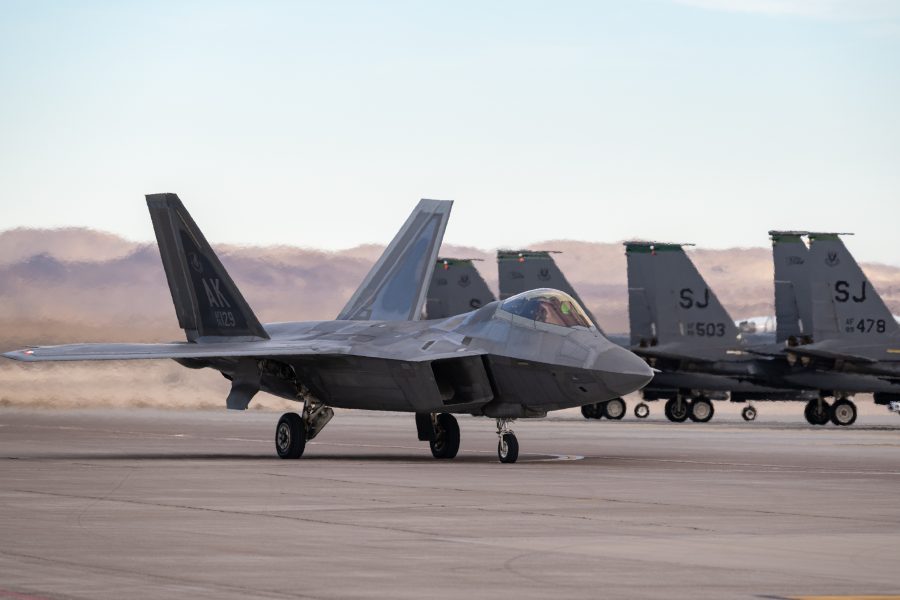Air Force readiness is “continuing to spiral downward” says the Heritage Foundation in its latest comprehensive assessment of the U.S. military, which labels USAF’s capability as “very weak,” the lowest possible grade on the conservative think tank’s five-point scale.
The Space Force, meanwhile, scored an upgrade over a year ago, moving up from “weak” to “marginal,” the mid-point on the scale.
The low Air Force score stemmed from lagging mission-capable rates and aircrew training, as well as questionable “deployability,” according to Heritage’s assessment, which was based on 2023 data released Jan. 24. It was particularly critical of USAF’s capacity to endure a conflict with a peer competitor.
Air Force Secretary Frank Kendall has expressed similar concerns in recent months. Last September, Kendall launched a sweeping review to “re-optimize” the Air Force, and he had begun to question readiness openly as early as last August.
“If we were asked tomorrow to go to war against a great power, either Russia or China, would we be really ready to do that?” Kendall said in an August livestream on Facebook. “I think the answer is not as much as we could be, by a significant margin.”
Air Force leaders will detail the findings and plans stemming from the “re-optimization” study at the AFA Warfare Symposium, Feb. 12-14. Officials began rolling out force projection concepts, including how they aim to implement the Air Force Force Generation model (AFFORGEN), and plans to create “Air Task Forces” last fall. Those plans are also still evolving, with clues anticipated to be announced at the conference.
Vice Chief of Staff Gen. James C. Slife has described the operational effect of this shift as reversing a years-long trend of prioritizing efficiency and instead prioritizing mission-effectiveness. AFFORGEN is intended to “articulate capacity, risk, and readiness to the joint force,” Slife has told Air & Space Forces Magazine, while future deployable units are intended to package together capabilities and train together, so units are ready to operate as a team the instant they are called to action.
Both issues were raised in the Heritage Foundation report, the Air Force section of which was led by senior research fellow John Venable, a retired colonel and 25-year Air Force veteran.
AFFORGEN establishes a two-year cycle for deployable units with four six-month phases, including time to “reset” and train. But Venable argued that the Air Force has not invested enough in flying time to properly train aircrew for the kind of combat they would face in a near-peer fight.
“The last time fighter pilots received an average of 150 hours of flying time and more than two sorties a week for an entire year was in 2015,” Venable wrote. The Air Force’s historic standard used to be 200 hours per year and three sorties per week.
The service’s flying hours budget has not increased in proportion with the rest of the budget, and the total number of hours has actually dipped in recent years. If Airmen do not receive enough opportunities to prepare and train, AFFORGEN “represents little more than an attempt to change the dialogue surrounding what are perhaps the lowest levels of readiness in Air Force history,” Venable wrote.
Aircraft material readiness is also in decline, Venable argued, noting low mission-capable rates for the F-22 and B-1, in particular—further limiting the time aircrew can fly in them to develop critical skills.
The Air Force needs three Active-Duty squadrons to send two forward, Venable wrote. That’s why “up until the end of the Cold War, the Air Force was organized using a three-squadron wing to handle the associated load.”
But as the Air Force consolidated and centralized forces into fewer squadrons per wing, and as deployments morphed into force packages of aircraft and personnel, that construct has broken down.
“We deployed wings to Desert Storm,” Slife said in September at AFA’s Air, Space & Cyber conference. “We no longer deploy wings … we deploy bespoke collections of UTCs that have never trained together before they get to where the action is. That has been an efficient way to operate. It largely works in a relatively uncontested environment where you have large main fixed operating bases that are going to be free from attack. That’s not the world we’re living in anymore.”
Even now, the Air Force is struggling to meet its manning requirements and needs to pull pilots and personnel from across units, Venable argued. In the event of an emerging crisis with a near-peer competitor, the Air Force would need to surge and sustain a high tempo of operations.
Venable argues that’s left the Air Force all but broken. “There is not a fighter squadron in the Air Force that holds the readiness levels, competence, and confidence levels that it would need to square off against a peer competitor, and readiness is continuing to spiral downward,” Venable declared.

Space Force Rising
Heritage was less critical of the Space Force, upgrading its score from “weak” to “marginal,” the middle grade on its 1-to-5 scale.
Venable cited across-the-board improvements in USSF capacity, capability, and readiness. “The trend lines for capability and capacity are improving rapidly, and this could bode well for the service in 2024 and beyond,” he noted.
The Space Force is capable of meeting global and strategic-level requirements for positioning, navigation, and timing (PNT); for communications; and for intelligence, surveillance, and reconnaissance (ISR). It still has work to do, however, in meeting tactical and operational requirements, Venable said.
Such requirements are the focus of efforts such as the Space Development Agency’s Proliferated Warfighter Space Architecture, which will deploy hundreds of satellites in low-Earth orbit to provide missile warning and tracking and serve as the backbone of Joint-All Domain Command and Control. Full fielding is still several years away, though.
